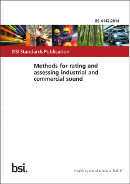
by Brianna Crandall — January 2, 2015—BSI, the U.K.-based business standards company, has recently revised BS 4142 Methods for rating and assessing industrial and commercial sound, which can be used for assessing how nearby residents and communities are affected by sound of a commercial or industrial nature. BS 4142 determines sound levels for the purpose of investigating complaints, but could also be useful for facilities managers striving to abate noise in their facilities to an acceptable level for surrounding communities.
The standard aims to offer consistency across varied practical situations, ranging from the noise of a single air-conditioning unit at a single workshop affecting a few people, to a large installation such as an oil refinery. It can also be used to assess sound at proposed new dwellings or premises used for residential purposes.
First published in 1967 and last revised in 1997, BS 4142 is the recognized standard in the U.K. for accurately assessing noise complaints. Without a consistent method, penalties could be incorrectly applied on industry. It also supports current U.K. planning guidance and Environment Agency guidance and has been extensively used in planning issues and public enquiries.
BS 4142 covers sound from:
- Industrial and manufacturing processes
- Fixed installations that comprise mechanical and electrical plant and equipment
- Loading and unloading of goods and materials at industrial and/or commercial premises
- Mobile plant and vehicles that are an intrinsic part of the overall sound emanating from premises or processes, such as from forklift trucks, or from train or ship movements on or around an industrial and/or commercial site
The standard also includes examples of different types of scenarios that may occur and need assessment. It does not include sound from the passage of vehicles on public roads and railway systems, certain recreational activities or entertainment.
BS 4142 was revised using a consensus-based approach with input from experts such as ANC (Association of Noise Consultants), DEFRA (U.K. Department for Environment Food & Rural Affairs) and IOA (Institute of Acoustics). It also included expertise across a wide range of industry already using the standard, including environmental health and environment agencies, and accounts for the changes to instrumentation in acoustic standards.





